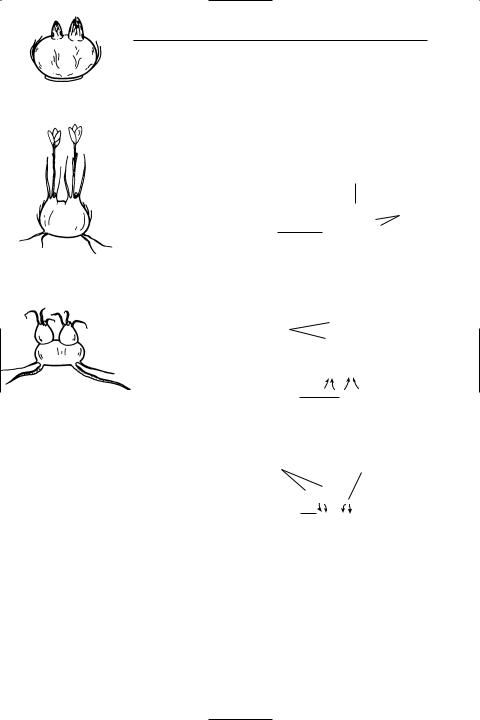
A Dictionary of Science
.pdf
Copernicus, Nicolaus |
196 |
system was correct, resulted in De revolutionibus being placed on the Index of forbidden books, where it remained until 1835.
cCopernicus, Nicolaus (Mikolaj Kopernik; 1473–1543) Polish astronomer, who studied mathematics and optics. By 1514 he had formulated his proposal that the planets, including the earth, orbit the sun in circular paths, although it was not formally published until the year he died. This refutation of an earth-centred universe raised hostile opposition from the church as well as from other astronomers.
copolymer See polymer.
copper Symbol Cu. A red-brown *transi-
tion element; a.n. 29; r.a.m. 63.546; r.d. 8.92; m.p. 1083.4°C; b.p. 2567°C. Copper has been extracted for thousands of years; it was known to the Romans as cuprum, a name linked with the island of Cyprus. The metal is malleable and ductile and an excellent conductor of heat and electricity. Copper-containing minerals include
cuprite (Cu2O) as well as azurite (2CuCO3.Cu(OH)2), chalcopyrite (CuFeS2), and malachite (CuCO3.Cu(OH)2). Native copper appears in isolated pockets in some parts of the world. The large mines in the USA, Chile, Canada, Zambia, Democratic Republic of Congo, and Peru extract ores containing sulphides, oxides, and carbonates. They are usually worked by smelting, leaching, and electrolysis. Copper metal is used to make electric cables and wires. Its alloys, brass (copper–zinc) and bronze (copper–tin), are used extensively.
Water does not attack copper but in moist atmospheres it slowly forms a characteristic green surface layer (patina). The metal will not react with dilute sulphuric or hydrochloric acids, but with nitric acid oxides of nitrogen are formed. Copper compounds contain the element in the +1 and +2 oxidation states. Copper(I) compounds are mostly white (the oxide is red). Copper(II) salts are blue in solution. The metal also forms a large number of coordination complexes.
copperas See iron(ii) sulphate.
copper(I) chloride A white solid compound, CuCl; cubic; r.d. 4.14; m.p. 430°C;
b.p. 1490°C. It is obtained by boiling a solution containing copper(II) chloride, excess copper turnings, and hydrochloric acid. Copper(I) is present as the [CuCl2]– complex ion. On pouring the solution into air-free distilled water copper(I) chloride precipitates. It must be kept free of air and moisture as it oxidizes to copper(II) chloride under those conditions.
Copper(I) chloride is essentially covalent and its structure is similar to that of diamond; i.e. each copper atom is surrounded tetrahedrally by four chlorine atoms and vice versa. In the vapour phase, dimeric and trimeric species are present. Copper(I) chloride is used in conjunction with ammonium chloride as a catalyst in the dimerization of ethyne to but-1-ene-3- yne (vinyl acetylene), which is used in the production of synthetic rubber. In the laboratory a mixture of copper(I) chloride and hydrochloric acid is used for converting benzene diazonium chloride to chlorobenzene – the Sandmeyer reaction.
copper(II) chloride A brown-yellow powder, CuCl2; r.d. 3.386; m.p. 620°C. It exists as a blue-green dihydrate (rhombic; r.d. 2.54; loses H2O at 100°C). The anhydrous solid is obtained by passing chlorine over heated copper. It is predominantly covalent and adopts a layer structure in which each copper atom is surrounded by four chlorine atoms at a distance of 0.23 nm and two more at a distance of 0.295 nm. A concentrated aqueous solution is dark brown in colour due to the presence of complex ions such as [CuCl4]2–. On dilution the colour changes to green and then blue because of successive replacement of chloride ions by water molecules, the Ünal colour being that of the [Cu(H2O)6]2+ ion. The dihydrate can be obtained by crystallizing the solution.
copper glance A mineral form of copper(I) sulphide, Cu2S.
copper(II) nitrate A blue deliquescent solid, Cu(NO3)2.3H2O; r.d. 2.32; m.p. 114.5°C. It may be obtained by reacting either copper(II) oxide or copper(II) carbonate with dilute nitric acid and crystallizing the resulting solution. Other hydrates containing 6 or 9 molecules of water are known. On heating it readily decomposes to give copper(II) oxide, nitrogen dioxide,

197 |
Coriolis force |
and oxygen. The anhydrous form can be obtained by reacting copper with a solution of nitrogen dioxide in ethyl ethanoate. It sublimes on heating suggesting that it is appreciably covalent.
copper(I) oxide A red insoluble solid, Cu2O; r.d. 6.0; m.p. 1235°C. It is obtained by reduction of an alkaline solution of copper(II) sulphate. Since the addition of alkalis to a solution of copper(II) salt results in the precipitation of copper(II) hydroxide the copper(II) ions are complexed with tartrate ions; under such conditions the concentration of copper(II) ions is so low that the solubility product of copper(II) hydroxide is not exceeded.
When copper(I) oxide reacts with dilute sulphuric acid a solution of copper(II) sulphate and a deposit of copper results, i.e. disproportionation occurs.
Cu2O + 2H+ → Cu2+ + Cu + H2O
When dissolved in concentrated hydrochloric acid the [CuCl2]– complex ion is formed. Copper(I) oxide is used in the manufacture of rectiÜers and the production of red glass.
copper(II) oxide A black insoluble solid, CuO; monoclinic; r.d. 6.3; m.p. 1326°C. It is obtained by heating either copper(II) carbonate or copper(II) nitrate. It decomposes on heating above 800°C to copper(I) oxide and oxygen. Copper(II) oxide reacts readily with mineral acids on warming, with the formation of copper(II) salts; it is also readily reduced to copper on heating in a stream of hydrogen. Copper(II) oxide is soluble in dilute acids forming blue solutions of cupric salts.
copper pyrites See chalcopyrite.
copper(II) sulphate A blue crystalline solid, CuSO4.5H2O; triclinic; r.d. 2.284. The pentahydrate loses 4H2O at 110°C and the Üfth H2O at 150°C to form the white anhydrous compound (rhombic; r.d. 3.6; decomposes above 200°C). The pentahydrate is prepared either by reacting copper(II) oxide or copper(II) carbonate with dilute sulphuric acid; the solution is heated to saturation and the blue pentahydrate crystallizes out on cooling (a few drops of dilute sulphuric acid are generally added to prevent hydrolysis). It is obtained on an industrial scale by forcing air through a
hot mixture of copper and dilute sulphuric acid. In the pentahydrate each copper(II) ion is surrounded by four water molecules at the corner of a square, the
Üfth and sixth octahedral positions are oc- c cupied by oxygen atoms from the sul-
phate anions, and the Üfth water molecule is held in place by hydrogen bonding. Copper(II) sulphate has many industrial uses, including the preparation of the Bordeaux mixture (a fungicide) and the preparation of other copper compounds. It is also used in electroplating and textile dying and as a timber preservative. The anhydrous form is used in the detection of traces of moisture.
Copper(II) sulphate pentahydrate is also known as blue vitriol.
copulation See sexual intercourse.
coral Any of a group of sedentary colonial marine invertebrates belonging to the class Anthozoa of the phylum *Cnidaria. A coral colony consists of individual *polyps within a protective skeleton that they secrete: this skeleton may be soft and jelly-like, horny, or stony. The horny skeleton secreted by corals of the genus Corallium, especially C. rubrum, constitutes the red, or precious, coral used as a gemstone. The skeleton of stony, or true, corals consists of almost pure calcium carbonate and forms the coral reefs common in tropical seas.
cordite An explosive mixture of cellulose nitrate and nitroglycerin, with added plasticizers and stabilizers, used as a propellant for guns.
core 1. A rod or frame of magnetic material that increases the inductance of a coil through which it passes. Cores are used in transformers, electromagnets, and the rotors and stators of electrical machines. It may consist of laminated metal, ferrite, or compressed ferromagnetic particles in a matrix of an insulating binder (dust core). 2. The inner part of a *nuclear reactor in which the nuclear reaction takes place. 3. The devices that make up the memory in certain types of computer. 4. The central region of a star or planet.
Coriolis force A Üctitious force sometimes used to simplify calculations involv-

cork |
198 |
ing rotating systems, such as the movement of air, water, and projectiles over the surface of the rotating earth. The concept was Ürst used in 1835 by Gaspard de
cCoriolis (1792–1843), a French physicist. The daily rotation of the earth means that in 24 hours a point on its equator moves a distance of some 40 000 kilometres, giving it a tangential velocity of about 1670 kilometres per hour. A point at the latitude of, say, Rome, travels a shorter distance in the same time and therefore has a lower tangential velocity – about
1340 km/hr. Air over the equator has the full tangential velocity of 1670 km/hr and as it travels north, say, it will retain this velocity; to an observer outside the earth this would be clear. However, to an observer in Rome it appears to be moving eastwards, because the earth at that point
is moving eastwards more slowly than the air. The Coriolis force (which is quite Üctitious) is the force that a naive observer thinks is needed to push the air eastwards.
cork (phellem) A protective waterproof plant tissue produced by the *cork cambium. It develops in plants undergoing *secondary growth and replaces the epidermis. Its cells, whose walls are impreg-
nated with *suberin, are arranged in radial rows and Üt closely together except
where the cork is interrupted by *lenticels. Some cork cells become air-Ülled while others contain deposits of lignin, tannins, and fatty acids, which give the cork a particular colour. The cork oak (Quercus suber) produces cork that can be used commercially.
cork cambium (phellogen) A type of
*cambium arising within the outer layers of the stems of woody plants, usually as a complete ring surrounding the inner tissues. The cells of the cork cambium divide to produce an outer corky tissue (*cork or phellem) and an inner secondary cortex (phelloderm). Cork, cork cambium, and phelloderm together make up the periderm, an impermeable outer layer that protects the inner stem tissues if the outer tissues split as the stem girth increases with age. It thus takes over the functions of the epidermis.
corm An underground organ formed by
certain plants, e.g. crocus and gladiolus, that enables them to survive from one growing season to the next (see illustration). It consists of a short swollen foodstoring stem surrounded by protective scale leaves. One or more buds in the axils of scale leaves produce new foliage leaves and Ûowers in the subsequent season, using up the food stored in the stem. Compare bulb.
|
bud |
|
scale |
swollen |
leaves |
|
|
stem |
|
|
winter |
flower and |
|
foliage leaves |
|
corm shrivels as |
|
food used for |
|
growing plant |
|
|
spring |
withered |
new bud |
foliage |
|
leaves |
|
swelling stem |
|
forming new |
|
corm |
|
autumn
Development of a corm
cornea A transparent layer of tissue, continuous with the *sclerotic, that forms the front part of the vertebrate eye, over the iris and lens. The cornea refracts light entering the eye onto the lens, thus assist-

199 |
corundum |
ing in the focusing of images onto the
*retina. See also astigmatism.
corniÜcation See keratinization.
CORN rule See absolute configuration.
corolla The *petals of a Ûower, collectively, forming the inner whorl of the *perianth. It encircles the stamens and carpels. The form of the corolla is very variable. The petals may either be free (polypetalous) or united to form a tube (gamopetalous or sympetalous).
corona 1. The outer part of the sun’s atmosphere. Its two main components are the K-corona (or inner corona), with a temperature of about 2 × 106 K at a height of some 75 000 km, and the F-corona (or outer corona), which is considerably cooler and extends for several million kilometres into space. 2. A glowing region of the air surrounding a conductor when the potential gradient near it exceeds a critical value. It is caused by ionization of the air and may be accompanied by hissing sounds. Corona discharge (or point discharge) occurs at sharp points where the surface charge density is high by the attraction, charging, and consequent repulsion of air molecules.
coronary vessels Two pairs of blood vessels (the coronary arteries and coronary veins) that supply the muscles of the heart itself. The coronary arteries arise from the aorta and divide into branches that encircle the heart. A blood clot in a coronary artery (coronary thrombosis) is one of the causes of a ‘heart attack’.
corpus callosum The sweeping band (commissure) of *white matter that provides a connection between the two halves of the cerebrum in the brain. It enables the transfer of information from one cerebral hemisphere to the other.
corpuscular theory See light.
corpus luteum (yellow body) The yellowish mass of tissue that forms in the cavity of a *GraaÜan follicle in the ovary of a mammal after the release of the egg cell. It secretes the hormone *progesterone. Some species of sharks, reptiles, and birds have similar structures in their
ovaries but the function of these is less well understood.
corrosion Chemical or electrochemical attack on the surface of a metal. See also
electrolytic corrosion; rusting. |
c |
|
|
cortex 1. (in botany) The tissue between |
|
the epidermis and the vascular system in |
|
plant stems and roots. It is composed of |
|
*parenchyma cells and shows little or no |
|
structural differentiation. Cortex is pro- |
|
duced by activity of the *apical meristem. |
|
See also endodermis. 2. (in zoology) The |
|
outermost layer of tissue of various or- |
|
gans, including the adrenal glands |
|
(adrenal cortex), kidneys (renal cortex), |
|
and cerebral hemispheres (see cerebral |
|
cortex). |
|
corticosteroid Any of several hor- |
|
mones produced by the cortex of the |
|
*adrenal glands. Glucocorticoids regulate |
|
the use of carbohydrates, proteins, and |
|
fats in the body and include *cortisol and |
|
*cortisone. Mineralocorticoids regulate |
|
salt and water balance (see aldosterone). |
|
corticotrophin See acth. |
|
cortisol (hydrocortisone) A hormone (see |
|
corticosteroid), produced by the adrenal |
|
glands, that promotes the synthesis and |
|
storage of glucose and is therefore impor- |
|
tant in the normal response to stress, sup- |
|
presses or prevents inÛammation, and |
|
regulates deposition of fat in the body. It |
|
is used as treatment for various allergies |
|
and for rheumatic fever, certain skin con- |
|
ditions, and adrenal failure (Addison’s dis- |
|
ease). |
|
cortisone A biologically inactive |
|
*corticosteroid produced in the adrenal |
|
glands from the active hormone *cortisol, |
|
which is structurally very similar to it. |
|
Cortisone is reconverted to cortisol in the |
|
liver and other organs. Cortisone may be |
|
administered therapeutically as an inac- |
|
tive precursor (prodrug) of cortisol. |
|
corundum A mineral form of alu- |
|
minium oxide, Al2O3. It crystallizes in |
|
the trigonal system and occurs as well- |
|
developed hexagonal crystals. It is colour- |
|
less and transparent when pure but the |
|
presence of other elements gives rise to a |
|
variety of colours. *Ruby is a red variety |
|
containing chromium; *sapphire is a blue |
|

corymb |
200 |
variety containing iron and titanium. Corundum occurs as a rock-forming mineral in both metamorphic and igneous rocks. It is chemically resistant to weath-
cering processes and so also occurs in alluvial (placer) deposits. The second hardest mineral after diamond (it has a hardness of 9 on the Mohs’ scale), it is used as an abrasive.
corymb A type of Ûowering shoot (see
racemose inflorescence) in which the lower Ûower stalks are longer than the higher ones, resulting in a Ûat-topped cluster of Ûowers. Examples are candytuft and wallÛower.
cos See trigonometric functions. cosecant See trigonometric functions. cosech See hyperbolic functions.
cosh See hyperbolic functions. cosine See trigonometric functions.
cosine rule In any triangle, with sides of length a, b, and c, c2 = a2 + b2 – 2abcosθ, where θ is the angle between sides a and b.
cosmic censorship A hypothesis concerning singularities and *black holes in the general theory of *relativity. It was
suggested in 1969 by the British physicist Roger Penrose (1931– ). The cosmic censorship conjecture asserts that all singularities in general relativity are hidden behind an event horizon. The conjecture has never been proved mathematically, although there is some evidence for it in many situations. Even if cosmic censorship is not correct, singularities would not be seen experimentally if the singularities are removed by *quantum gravity. It may be that in classical general relativity the cosmic censorship hypothesis is true for ‘reasonable’ physical situations but that it is possible to construct counter-examples to it for various special situations.
cosmic radiation High-energy particles that fall on the earth from space. Primary cosmic rays consist of nuclei of the most abundant elements, with *protons (hydrogen nuclei) forming by far the highest proportion; electrons, positrons, neutrinos, and gamma-ray photons are also present. The particle energies range from
10–11 J to 10 J (108 to 1020 eV) and as they enter the earth’s atmosphere they collide with oxygen and nitrogen nuclei producing secondary cosmic rays. The secondary rays consist of elementary particles and gamma-ray photons. A single high-energy primary particle can produce a large shower of secondary particles. The sources of the primary radiation are not all known, although the sun is believed to be the principal source of particles with energies up to about 1010 eV. It is believed that all particles with energies of less than 1018 eV originate within the Galaxy.
cosmic string See string.
cosmid A hybrid *vector, used in *gene cloning, that includes the cos gene (from the lambda bacteriophage). It also contains drug resistance *marker genes and other plasmid genes. Cosmids can incorporate larger DNA fragments than either phage or plasmid vectors alone and are especially suitable for cloning large mammalian genes or multigene fragments.
cosmoid scale See scales.
cosmological constant A term that can be added to Einstein’s Üeld equation for general *relativity theory. The cosmological constant is independent of space and time. It was put forward by Einstein in 1917 to allow for the possibility of a static universe. Although the discovery of the *expansion of the universe removed the original motivation for the cosmological constant, the discovery that the expansion of the universe is accelerating suggests that the constant has a non-zero value, albeit by a factor of 10120 smaller than expected theoretically. Explaining this small non-zero value is one of the main challenges for theoretical physics at the present time.
cosmological principle The claim that on extremely large scales, i.e. much greater scales than those associated with *large-scale structure, the universe is homogeneous and isotropic. There is some evidence that the cosmological principle is valid, notably from the cosmic microwave background radiation, but it cannot be said to have been demonstrated conclusively.
cosmology The study of the nature, ori-

201 |
cotyledon |
gin, and evolution of the universe. Various theories concerning the origin and evolution of the universe exist. See Chronology. See also big-bang theory; steady-state theory; early universe.
cotangent See trigonometric func-
tions.
coth See hyperbolic functions.
Cottrell precipitator An electrostatic precipitator used to remove dust particles from industrial waste gases, by attracting them to charged grids or wires.
cotyledon (seed leaf) A part of the embryo in a seed plant. The number of cotyledons is an important feature in classifying plants. Among the Ûowering
plants, the class known as *Monocotyle- c doneae have a single cotyledon and *Dicotyledoneae have two. Conifers have
either two cotyledons, as in Taxus (yews), or Üve to ten, as in Pinus (pines). In seeds without an *endosperm, e.g. garden pea and broad bean, the cotyledons store food, which is used in germination. In seeds showing *epigeal germination, e.g. runner bean, they emerge above the soil
COSMOLOGY
260 BC |
Greek astronomer Aristarchus of Samos (c. 320–230 BC) proposes a sun- |
|
centred universe. |
c.150 AD |
Greek-Egyptian astronomer Ptolemy (2nd century AD) proposes an earth- |
|
centred universe. |
1543 |
Copernicus publishes his sun-centred theory of the universe (solar |
|
system). |
1576 |
English mathematician Thomas Digges (c. 1546–95) proposes that the |
|
universe is infinite (because stars are at varying distances). |
1584 |
Italian philosopher Giordano Bruno (1548–1600) states that the universe |
|
is infinite. |
1633 |
Galileo champions Copernicus’s sun-centred universe, but is forced by |
|
the Roman Catholic Inquisition to recant. |
1854 |
Helmholtz predicts the heat death of the universe, based on thermo- |
|
dynamics. |
1917 |
Einstein proposes a static universe theory. |
1922 |
Russian astronomer Alexander Friedmann proposes the expanding |
|
universe theory. |
1927 |
George Lemaître proposes the big-bang theory of the universe. |
1929 |
Edwin Hubble demonstrates the expansion of the universe. |
1948 |
US physicists George Gamow (1904–68), Ralph Alpher (1921– ), and |
|
Hans Bethe (1906– ) develop the big-bang theory, and the α-β-γ |
|
theory of the origin of the elements; Alpher also predicts that the big |
|
bang would have produced a microwave background. |
|
British astronomers Herman Bondi (1919– ), Thomas Gold (1920– |
|
2004), and Fred Hoyle propose the steady-state theory of the universe. |
1965 |
US astrophysicists Arno Penzias (1933– ) and Robert Wilson (1936– ) |
|
discover the microwave background radiation. |
1980 |
US physicist Allan Guth (1947– ) proposes the inflationary theory of |
|
the universe. |
1992 |
US COBE astronomical satellite detects ripples in residual cosmic |
|
radiation (cited as evidence of the big bang). |

coudé system |
202 |
surface and become the Ürst photosynthetic leaves.
coudé system See telescope.
ccoulomb Symbol C. The *SI unit of electric charge. It is equal to the charge transferred by a current of one ampere in one second. The unit is named after Charles de Coulomb.
Coulomb, Charles Augustin de
(1736–1806) French physicist, who served as an army engineer in Martinique before returning to France. He is best known for his 1785 proposal of *inverse-square laws to describe the interaction between electrical charges and between magnets (see coulomb’s law), which he proved experimentally using a *torsion balance.
Coulomb explosion The sudden disruption of a molecule from which the electrons have been stripped to leave only the nuclei, which repel each other because of their electric charge. The technique of coulomb explosion imaging uses this effect to investigate the shape of mol-
ecules. A beam of high-energy neutral molecules is produced by Ürst adding elec-
trons, accelerating the ions in an electric Üeld, and then removing the electrons. The beam collides with a thin metal foil having a thickness of about 30 atoms. As the molecules pass through this foil their electrons are scattered and only the nuclei of the molecules emerge. The process occurs within a very short period of time, shorter than the time required for a complete molecular vibration, and consequently the nuclei retain the molecular shape until they are suddenly repulsed by the like charges. The nuclei then impinge on a detector that records their velocity and direction, thus enabling the spatial arrangement of the original molecule to be derived.
Coulomb Üeld See coulomb’s law.
Coulomb force See coulomb’s law.
Coulomb’s law The force (sometimes called the Coulomb force) between two charged particles, regarded as point
charges Q 1 and Q 2 a distance d apart, is proportional to the product of the charges and inversely proportional to the square of the distance between them. The law is
now usually stated in the form F =
Q 1Q 2/4πεd2, where ε is the absolute *permittivity of the intervening medium. ε = εrε0, where εr is the relative permittivity (the dielectric constant) and ε0 is the electric constant. The electric Üeld surrounding a point charge is called the Coulomb Üeld and the scattering of charged particles by the Coulomb Üeld surrounding an atomic nucleus is called Coulomb scattering. The law was Ürst published by Charles de Coulomb in 1785.
counter Any device for detecting and counting objects or events, often incident charged particles or photons. The latter devices usually work by allowing the particle to cause ionization, which creates a current or voltage pulse. The pulses are then counted electronically. See cerenkov counter; crystal counter; geiger counter; proportional counter; scintillation counter; spark counter. These names are often applied merely to the actual detectors; the ancillary counting mechanism is then called a *scaler.
countercurrent heat exchange A
*counterÛow mechanism that enables Ûuids at different temperatures Ûowing in channels in opposite directions to exchange their heat content without mixing. An example of countercurrent heat exchange occurs in the feet of penguins, in which heat from blood in the arteries supplying the feet is transferred to blood returning to the body’s core in veins that lie close to these arteries. This helps to maintain the core temperature in freezing conditions.
counterÛow The Ûow of two Ûuids in apposed vessels in opposite directions. In biological systems such an arrangement enables the efÜcient transfer of heat, ions, molecules, etc., from Ûuids that are rich in these resources to Ûuids that are deÜcient in them.
country rock (host rock) Older rock that surrounds veins of minerals or an igneous magma *intrusion, such as a *batholith.
The extreme heat of the intrusion may cause changes (contact metamorphism) in the composition of the adjacent country rock.
couple Two equal and opposite parallel

203 |
Cowper’s glands |
forces applied to the same body that do not act in the same line. The forces create a torque, the *moment of which is equal to the product of the force and the perpendicular distance between them.
coupling 1. (in physics) An interaction between two different parts of a system or between two or more systems. Examples of coupling in the *spectra of atoms and nuclei are *Russell–Saunders coupling, *j-j coupling, and spin–orbit coupling. In the spectra of molecules there are Üve idealized ways (called the Hund coupling cases) in which the different types of angular momentum in a molecule (the electron orbital angular momentum L, the electron spin angular momentum S, and the angular momentum of nuclear rotation N) couple to form a resultant angular momentum J. (In practice, the coupling for many molecules is intermediate between Hund’s cases due to interactions, which are ignored in the idealized cases.) In *solid-state physics an example of coupling is electron–phonon coupling, the analysis of which gives the theories of electrical *conductivity and *superconductivity. See also coupling constant.
2. (in chemistry) A type of chemical reaction in which two molecules join together; for example, the formation of an *azo compound by coupling of a diazonium ion with a benzene ring.
coupling constant A physical constant that is a measure of the strength of interaction between two parts of a system or two or more systems. In the case of a *Üeld theory, the coupling constant is a measure of the magnitude of the force exerted on a particle by a Üeld. In the case of a *quantum Üeld theory, a coupling constant is not constant but is a function of energy, the dependence on energy being described by the *renormalization group.
See also coupling; asymptotic freedom.
courtship Behaviour in animals that plays a part in the initial attraction of a mate or as a prelude to copulation.
Courtship often takes the form of *displays that have evolved through *ritualization; some are derived from other contexts (e.g. food begging in some birds). Chemical stimuli (see pheromone) are also important in many mammals and insects.
As well as ensuring that the prospective mate is of the same species, the male’s courtship performance allows females to choose between different males. The later stages of courtship may involve both part-
ners in an alternating series of displays c that inhibit *aggression and fear re-
sponses and ensure synchrony of sexual arousal.
COV See crossover value.
covalent bond See chemical bond.
covalent crystal A crystal in which the atoms are held together by covalent bonds. Covalent crystals are sometimes called macromolecular or giant-molecular crystals. They are hard high-melting substances. Examples are diamond and boron nitride.
covalent radius An effective radius assigned to an atom in a covalent compound. In the case of a simple diatomic molecule, the covalent radius is half the distance between the nuclei. Thus, in Cl2 the internuclear distance is 0.198 nm so the covalent radius is taken to be 0.099 nm. Covalent radii can also be calculated for multiple bonds; for instance, in the case of carbon the values are 0.077 nm for single bonds, 0.0665 nm for double bonds, and 0.0605 nm for triple bonds. The values of different covalent radii can sometimes be added to give internuclear distances. For example, the length of the bond in interhalogens (e.g. ClBr) is nearly equal to the sum of the covalent radii of the halogens involved. This, however, is not always true because of other effects (e.g. ionic contributions to the bonding).
covariance In *statistics, a measure of the association between a pair of random variables. It equals the expected value of the product of their deviations (from the
mean value). For two sets of observations
_
(x1,y1_),…,(xn,yn), where x is the mean of xi and y is the mean of yi, it is given by
n _ _
(1/n) Σ(xi – x) (yi – y)
i = 1
See also variance.
Cowan, Clyde See pauli, wolfgang ernst.
Cowper’s glands (bulbourethral glands)
A pair of pea-sized glands that lie beneath the prostate gland. Cowper’s glands se-

coxa |
204 |
crete an alkaline Ûuid that forms part of the *semen. This Ûuid neutralizes the acidic environment of the urethra, thereby protecting the sperm. The glands
care named after William Cowper (1666–1709). See also seminal vesicle.
coxa The Ürst segment, attached to the thorax, of an insect’s leg. See also femur; trochanter.
CP invariance The symmetry generated by the combined operation of changing *charge conjugation (C) and *parity (P). CP violation occurs in weak interactions in kaon decay and in *B-mesons. See also cpt theorem; time reversal.
CPT theorem The theorem that the combined operation of changing *charge conjugation C, *parity P, and *time rever-
sal T, denoted CPT, is a fundamental *symmetry of relativistic *quantum Üeld theory. No violation of the CPT theorem is known experimentally. When C, P, and T
(or any two of them) are violated, the principles of relativistic quantum Üeld theory are not affected; however, violation of CPT invariance would drastically
alter the fundamentals of relativistic quantum Üeld theory. It is not known whether *superstrings obey versions of the CPT theorem.
CPU (central processing unit) The main operating part of a *computer; it includes the control unit (CU) and the arithmetic/ logic unit (see alu). Its function is to fetch instructions from memory, decode them, and execute the program. It also provides timing signals. An *integrated circuit that has a complete CPU on a single silicon chip is called a microprocessor.
cracking The process of breaking down chemical compounds by heat. The term is applied particularly to the cracking of
hydrocarbons in the kerosine fraction obtained from *petroleum reÜning to give smaller hydrocarbon molecules and alkenes. It is an important process, both as a source of branched-chain hydrocarbons suitable for gasoline (for motor fuel) and as a source of ethene and other alkenes. Catalytic cracking is a similar process in which a catalyst is used to lower the temperature required and to modify the products obtained.
cranial nerves Ten to twelve pairs of nerves in vertebrates that emerge directly from the brain. They supply the sense organs and muscles of the head, neck, and viscera. Examples of cranial nerves include the *optic nerve (II) and the *vagus nerve (X). With the *spinal nerves, the cranial nerves form an important part of the *peripheral nervous system.
cranial reÛex See reflex.
Craniata See chordata.
cranium (brain case) The part of the vertebrate *skull that encloses and protects the brain. It is formed by the fusion of several Ûattened bones, which have immovable joints (sutures) between them.
cream of tartar See potassium hydrogentartrate.
creatine A compound, synthesized from the amino acids arginine, glycine, and methionine, that occurs in muscle. In the form of creatine phosphate (or phosphocreatine), it is an important reserve of energy for muscle contraction, which is released when creatine phosphate loses its phosphate and is converted to creatinine, which is excreted in the urine (at a rate of 1.2–1.5 g/day in humans). See also
phosphagen.
creatinine See creatine.
creationist A proponent of the theory of *special creation.
creep The continuous deformation of a solid material, usually a metal, under a constant stress that is well below its yield point. It usually only occurs at high temperatures and the creep characteristics of any material destined to be used under conditions of high stress at high temperatures must be investigated.
cremocarp A dry fruit that is a type of *schizocarp formed from two one-seeded carpels. The carpels remain separate and form indehiscent mericarps that are attached to a central supporting strand (carpophore) for some time before dispersal. It is characteristic of the Umbelliferae (Apiaceae; carrot family).
crenation The shrinkage of cells that occurs when the surrounding solution is *hypertonic to the cellular cytoplasm.

205 |
critical mass |
Water leaves the cells by *osmosis, which causes the plasma membrane to wrinkle and the cellular contents to condense.
creosote 1. (wood creosote) An almost colourless liquid mixture of phenols obtained by distilling tar obtained by the destructive distillation of wood. It is used medically as an antiseptic and expectorant. 2. (coal-tar creosote) A dark liquid mixture of phenols and cresols obtained by distilling coal tar. It is used for preserving timber.
cresols See methylphenols.
Cretaceous The Ünal geological period of the Mesozoic era. It extended from about 144 million years ago, following the Jurassic, to about 65 million years ago, when it was succeeded by the Palaeocene epoch. The name of the period is derived from creta (Latin: chalk) and the Cretaceous was characterized by the deposition of large amounts of *chalk in western Europe. The Cretaceous was the time of greatest Ûooding in the Mesozoic. Angiosperm plants made their Ürst appearance on land and in the early Cretaceous Mesozoic reptiles reached their peak. At the end of the period there was a *mass extinction of the dinosaurs, Ûying reptiles, and ammonites, the cause of which may be related to environmental changes resulting from collisions of the earth with large meteorites (see alvarez event; iridium anomaly).
Creutzfeldt–Jakob disease (CJD) A disease of humans characterized by dementia and destruction of brain tissue, Ürst described by the German psychiatrists H. G. Creutzfeldt (1885–1964) and A. M. Jakob (1884–1931). It is now known to be caused by an abnormal *prion protein and is transmissible, although there is also an inherited familial form. This rare disease typically affects middle-aged and elderly people and leads to rapid mental deterioration and death. The abnormal prion interferes with the structure of normal prion protein in brain tissue, resulting in accumulations of the protein and consequent tissue damage. In most cases the source of infection is unknown. However, it is well established that infection can result, for example, via injections of growth hormone derived from infected
human cadavers. During the 1990s a novel form of the disease emerged, called variant CJD, which typically affects young healthy individuals. This is thought to be
caused by consumption of beef products c derived from cattle infected with *bovine spongiform encephalopathy.
Crick, Francis Harry Compton
(1916–2004) British molecular biologist, who in 1951 teamed up with James *Watson at Cambridge University to try to Ünd the structure of *DNA. This they achieved in 1953, using the X-ray diffraction data of Rosalind Franklin (1920–58) and Maurice Wilkins (1916–2004). Crick went on to investigate *codons and the role of transfer *RNA. Crick, Watson, and Wilkins shared a Nobel Prize in 1962.
crista 1. See semicircular canals. 2. See mitochondrion.
cristobalite A mineral form of *silicon(IV) oxide, SiO2.
critical angle See total internal reflection.
critical damping See damping.
critical density In astronomy, the mean density of the universe below which value it is an expanding and continuously open system. The luminous material in the universe (galaxies, etc.) is estimated to account for about 10% of this Ügure. The remainder is thought to consist mainly of dark matter (see missing mass).
critical group A large group of related organisms that, although variations exist between them, cannot be divided into smaller groups of equivalent taxonomic rank to the parent group. Critical groups are found among plants that reproduce by *apomixis; for example, the 400 or so species of Rubus (brambles, etc.) are regarded as a critical group.
critical mass The minimum mass of Üssile material that will sustain a nuclear *chain reaction. For example, when a nucleus of uranium–235 disintegrates two or three neutrons are released in the process, each of which is capable of causing another nucleus to disintegrate, so creating a chain reaction. However, in a mass of U–235 less than the critical mass, too
